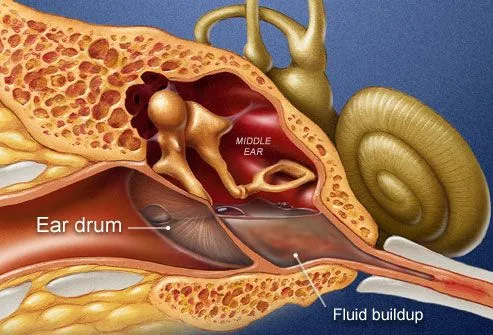Middle ear infections, also known as otitis media, can be a painful and discomforting condition affecting both adults and children. Recognizing the symptoms and understanding the causes of middle ear infections is crucial for timely diagnosis and effective treatment. In this article, we will explore the various aspects of middle ear infections, shedding light on common symptoms and underlying causes.
Ear Infection Symptoms
Recognizing the symptoms of a middle ear infection is the first step towards seeking appropriate medical attention. Key indicators include:
- Earache: One of the primary symptoms, earaches associated with middle ear infections can range from mild discomfort to intense pain.
- Fluid Drainage: In some cases, the infected ear may produce pus or other fluids, visible either inside the ear or draining from it.
- Hearing Loss: Temporary hearing impairment is common during a middle ear infection, particularly due to the accumulation of fluids.
- Irritability: Children, in particular, may display increased fussiness or irritability, often attributed to the pain and discomfort associated with the infection.
- Fever: A low-grade fever may accompany a middle ear infection, signaling the body’s immune response to the infection.

Causes of Middle Ear Infections
Understanding the root causes of middle ear infections is essential for prevention and effective management.
Bacterial or Viral Infections
- Streptococcus pneumoniae, Haemophilus influenzae, and Moraxella catarrhalis bacteria are among the most common culprits responsible for middle ear infections. Viruses such as respiratory syncytial virus (RSV) and influenza can also lead to infections. Bacterial or viral infections that affect the upper respiratory tract, such as the common cold or flu, can spread to the ear through the Eustachian tube, causing inflammation and infection.
Eustachian Tube Dysfunction
The Eustachian tubes play a crucial role in regulating air pressure in the middle ear. Allergies, sinus infections, or the presence of adenoids can lead to the obstruction of the Eustachian tubes, preventing proper drainage. In some cases, the Eustachian tubes may not function correctly, leading to improper equalization of pressure and creating an environment conducive to infection.
Anatomical Factors
In children, the Eustachian tubes are shorter and more horizontal than in adults. This anatomical difference makes it easier for bacteria or viruses to travel from the throat to the ear, increasing the likelihood of infections. Enlarged adenoids, located near the Eustachian tubes, can contribute to their blockage, impairing drainage and ventilation.
Environmental Factors
Exposure to secondhand smoke is a well-established risk factor for middle ear infections, particularly in children. Smoke can irritate the Eustachian tubes and compromise the immune system, making the ears more susceptible to infections. Children in daycare settings may be at a higher risk due to increased exposure to respiratory infections. Close proximity to other children increases the likelihood of sharing germs that can lead to ear infections.
Sinus Infections
Inflammation and infection in the sinuses can extend to the middle ear, especially when the Eustachian tubes become blocked. This connection between the sinuses and the middle ear can result in the spread of pathogens.
Allergies
Allergies, particularly those affecting the respiratory system, can contribute to Eustachian tube dysfunction. Inflammation caused by allergies can lead to blockages, hindering proper drainage and ventilation in the middle ear.
Understanding these detailed causes of infections is essential for implementing preventive measures and seeking timely medical intervention when symptoms arise. Individuals with a history of recurrent ear infections or those experiencing persistent symptoms should consult a healthcare professional for proper diagnosis and treatment.

Preventing Middle Ear Infections
While some risk factors may be unavoidable, there are steps individuals can take to reduce their susceptibility to middle ear infections:
- Practice Good Hygiene: Regular handwashing, especially during cold and flu seasons, can help prevent the spread of infections that may lead to infections.
- Avoid Smoking: Secondhand smoke can increase the risk of ear infections, so it’s important to create a smoke-free environment.
- Vaccinations: Staying up-to-date with vaccinations, especially for children, can provide protection against certain infections that may lead to ear problems.
- Prompt Treatment of Respiratory Infections: Timely and adequate treatment of respiratory infections can prevent the spread of infections to the ears.
When to See A Doctor?
If you or your child experiences severe ear pain that persists, accompanied by symptoms such as fever or fluid drainage from the ear, it is advisable to seek medical attention promptly. Noticeable hearing loss, especially following a cold or respiratory infection, warrants a visit to the doctor. In the case of infants, increased fussiness, difficulty sleeping, or pulling on the ears may signal a potential ear infection, necessitating a healthcare professional’s evaluation.
If symptoms persist for more than a few days or if there’s a history of recurrent ear infections, consulting a doctor is recommended to prevent complications. Additionally, persistent cough or cold symptoms, coupled with other issues, should prompt a visit to assess the possibility of a middle ear infection. Balance issues or dizziness linked to ear symptoms are also concerning and warrant medical attention. If you are uncertain whether to seek medical help, it is advisable to consult with a healthcare professional for personalized advice. Early diagnosis and intervention can help manage symptoms effectively and prevent potential complications.